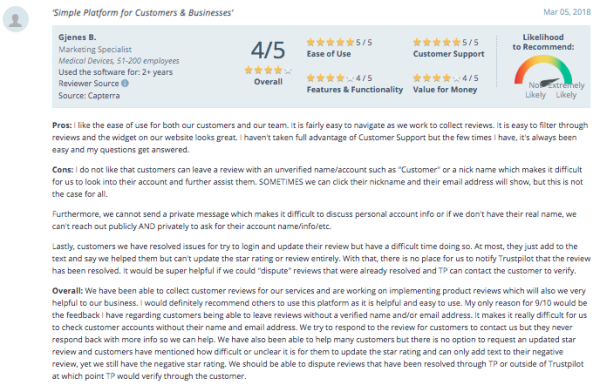The harsh reality of business these days is that your customers probably have hundreds—maybe even thousands—of options at their fingertips. Standing out in a world where the noise is getting louder every day is a job that simply isn’t going to get any easier.
The good news is it’s not hopeless.
An interesting phenomenon that has occurred in this age of constant connectedness is that the customer experience (CX) is overshadowing products and services themselves. In fact, according to a study from the consulting firm, Walker, CX is predicted to overtake price as the key brand differentiator by 2020.

Image source: SuperOffice
So where does this leave you?
Before we dive in, it’s important to note that the topic of “providing an excellent customer experience” is very extensive. Moreover, the specifics of this task will vary from industry-to-industry, company-to-company.
However, there is one common denominator: trust. Trust is the foundation of any relationship. On a basic level, there are many different ways you can create this with your customers. Here are four of the big ones.
1. Prioritize 360-degree customer reviews
Customer reviews are a pretty interesting concept. Anyone can leave public feedback about a business, product, or service, which plays an enormous role in buying decisions.
However, it’s important to note how the essence of online reviews has changed over the years. As the sheer power of reviews was beginning to be understood by businesses, many would resort to shady practices like forging their own stellar reviews—or paying others to do it. Fortunately, both consumers and the major reviews platforms wised up to this.
These days, the average customer radar for B.S. is very strong. It takes more than a handful of glowing reviews or quick star ratings to impress customers. Most people look at reviews to get an unfiltered, unbiased opinion before they pull out their wallets.
Take one of these Trustpilot reviews for example.

Image source: Capterra
The prompt of this review form is simple, yet works to get a top-to-bottom view of the product and provide a great deal of insight. Ultimately, a single review like this is going to be much more influential in gaining trust than a bunch of reviews that only have a one-star rating and a sentence or two.
That said, the name of the game is more focused on getting and showcasing honest reviews, rather than only stellar, 5-star reviews. Regardless of what you offer, make it a point to create your review forms in a way that gauges the customers’ likes, dislikes, overview, etc.
2. Be easy to reach
There is perhaps no better way to kill customer trust (and revenue) than being unresponsive to inquiries. Business hours these days never really end. Not having customer service options available around the clock is putting you at a serious disadvantage.
The majority of consumers expect an immediate response when they have a customer service question.
So how are most companies adapting to this intimidating reality?
First and foremost, you need to accept that buyer patience is at an all-time low. Consumers expect problems to be solved on their own terms: promptly and thoroughly.
With this in mind, incorporating a live chat feature on the company website is almost a requirement these days. Live chat is obviously better than forcing customers to wait on hold while listening to torturous elevator music. When you set up this feature, do your best to make it personable. Include a name and picture of the customer service rep.

Image source: Zendesk
Now, this is just the tip of the iceberg in setting up a powerful live chat strategy. Take your time and do this right!
Many businesses are also opting for chatbots. The purpose is to field frequently asked questions and help resolve issues around the clock, instantly.
Setting up a chatbot feature usually takes a bit of trial-and-error. You need to know what the common questions are and how to program the bot to answer them in the best way possible.
For a while now, MasterCard has been the gold standard in delivering top-notch service via chatbot.

Image source: G2
If you play your cards right in the programming process, your chatbot can be used as a sales associate—one that never sleeps, at that!Communication and trust go hand-in-hand. Even if you don’t have an instant resolution for every single customer query, the fact that you are responsive and on top of things does a lot to showcase your devotion to customer satisfaction.
3. Get to the root of common pain points
“Know thy customer” has been the standard business advice for thousands of years.
However, it’s a concept that not every business fully grasps. Plain and simple, building a strong degree of trust is dependent on your ability to understand pain points on a personal level. This is what separates good businesses and great businesses.
Getting to the nitty gritty details of your customer pain points doesn’t have to be a rigorous process. There is a common method of doing this called the “5 Whys.”
Essentially, this is an effective way of asking a series of related questions to a hypothetical customer until you get to the root cause. For example, let’s say you are selling project management software. The overarching problem for the customer is they need to get work done more efficiently.
Here’s how the 5 Whys method might work for you:
You: Why do you need a project management software?
Target Customer: My talented team is working very hard, yet struggling to meet deadlines.
You: Why are they struggling to meet deadlines?
Target Customer: They aren’t able to efficiently manage the workload.
You: Why aren’t they able to manage the workload?
Target Customer: They keep running into unnecessary snags in their workflow.
You: Why are there so many snags?
Target Customer: They are using too many separate tools for different tasks like communication, file sharing, status updates, etc.
You: Why is using so many tools a big problem?
Target Customer: It creates too many points of disconnect and it’s easy for crucial tasks to slip through the cracks.
By using a persistent line of questioning, you can get to the in-depth reasons why people need your product or service. Once you have these answers, the way you solve them is your unique selling proposition. This can be the core focus of your marketing and customer success messaging.
The better you understand the day-to-day pain points of your customers, the more inclined they will be to trust you.
4. Don't make bold promises
One thing to avoid in the business world is to be labeled a “talker.” The title of “talker” is almost always followed up by “not a doer.” Having this reputation is a terrible place to be. Moreover, it is the opposite of trust.
Making bold promises is almost always a high risk, high reward situation, and one you don’t want to be on the wrong side of. Remember the Segway? In 2001, Dean Kamen unveiled this invention and told Time Magazine the Segway “will be to the car what the car was to the horse and buggy within a year.”
Obviously, this didn’t pan out. While the promises were great, the delivery was poor. Priced at a steep $5,000, the Segway lacked practicality and never really caught on. Nowadays, the Segway is the butt of a multitude of jokes (thanks, Paul Blart!).
One of the worst examples of poor promising in recent memory is the infamous Fyre Festival. Founders Billy McFarland and rapper Ja Rule promised patrons a luxury music festival on an island in the Bahamas. What they actually delivered was one of the biggest train wrecks of the decade. Based on this event, it’s very likely that the people behind Fyre Festival will never earn any sort of consumer trust again.
Now, making bold claims every once in a while can certainly have its advantages. However, leaving too many of them unfulfilled (or making a REALLY bad one) can wreak serious, unrepairable havoc on consumer trust levels.
Wrapping up
Consumer trust is a very fragile thing. It’s something that can take years to establish, yet can be completely destroyed in minutes.
The process of getting the masses to trust a business is going to be unique for everyone. Whether you’re a new business or are working to gain more loyal customers, following these four tips will put you on the right path.


